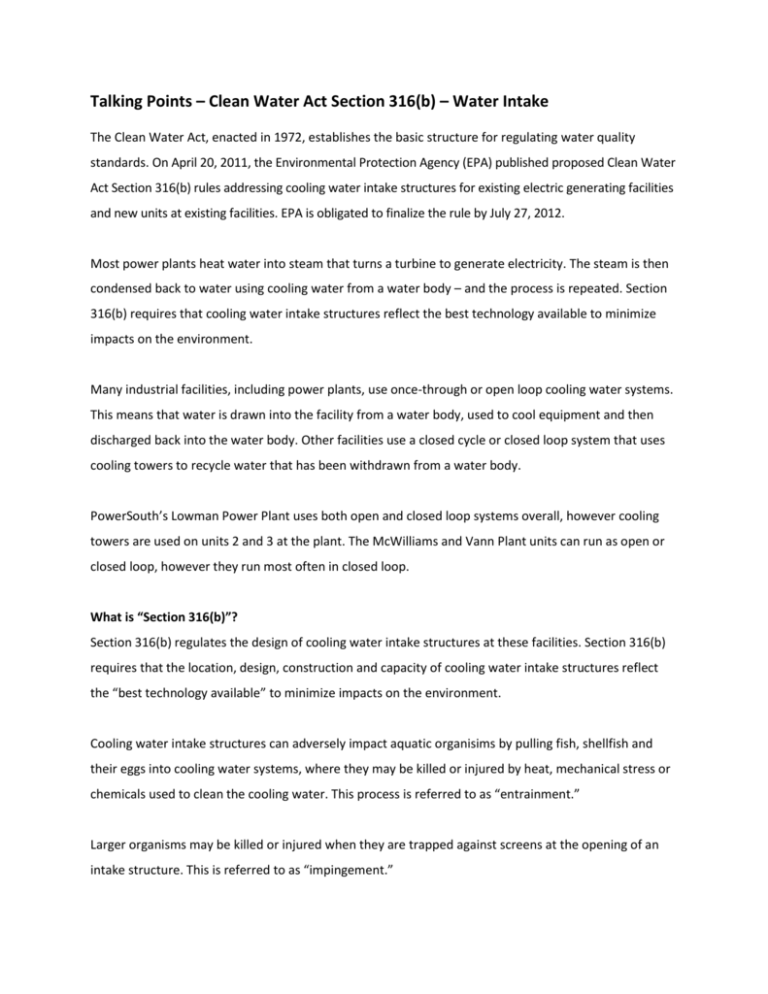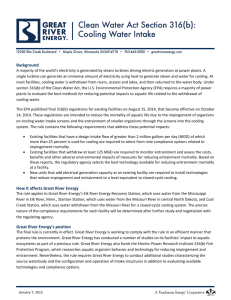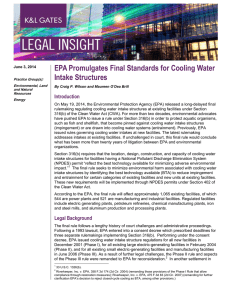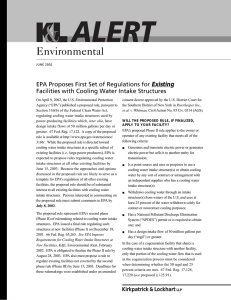Talking Points – Clean Water Act Section 316(b)
advertisement

Talking Points – Clean Water Act Section 316(b) – Water Intake The Clean Water Act, enacted in 1972, establishes the basic structure for regulating water quality standards. On April 20, 2011, the Environmental Protection Agency (EPA) published proposed Clean Water Act Section 316(b) rules addressing cooling water intake structures for existing electric generating facilities and new units at existing facilities. EPA is obligated to finalize the rule by July 27, 2012. Most power plants heat water into steam that turns a turbine to generate electricity. The steam is then condensed back to water using cooling water from a water body – and the process is repeated. Section 316(b) requires that cooling water intake structures reflect the best technology available to minimize impacts on the environment. Many industrial facilities, including power plants, use once-through or open loop cooling water systems. This means that water is drawn into the facility from a water body, used to cool equipment and then discharged back into the water body. Other facilities use a closed cycle or closed loop system that uses cooling towers to recycle water that has been withdrawn from a water body. PowerSouth’s Lowman Power Plant uses both open and closed loop systems overall, however cooling towers are used on units 2 and 3 at the plant. The McWilliams and Vann Plant units can run as open or closed loop, however they run most often in closed loop. What is “Section 316(b)”? Section 316(b) regulates the design of cooling water intake structures at these facilities. Section 316(b) requires that the location, design, construction and capacity of cooling water intake structures reflect the “best technology available” to minimize impacts on the environment. Cooling water intake structures can adversely impact aquatic organisims by pulling fish, shellfish and their eggs into cooling water systems, where they may be killed or injured by heat, mechanical stress or chemicals used to clean the cooling water. This process is referred to as “entrainment.” Larger organisms may be killed or injured when they are trapped against screens at the opening of an intake structure. This is referred to as “impingement.” Under the proposed rule, the majority of U.S. power plants will need to conduct biologic and technologic studies to determine the best methods of reducing environmental impacts to a measurable standard and demonstrate performance. For entrainment, EPA proposes that state environmental agencies set site-specific standards by evaluating technology options, including closed-cycle cooling (e.g., cooling towers), and requiring the “maximum reductions warranted” after consideration of site-specific factors, including costs and benefits. For impingement, EPA proposes stringent fish mortality and water intake velocity standards, without regard to site-specific factors that may make the standards unachievable. EPA requires the standards to be met at all times, despite natural variability that will make compliance technically impossible at many sites. When EPA rules required that facilities use the “best technology available,” they previously allowed permitting authorities to weigh costs and benefits of several technologies before making final decisions. In 2009, the Supreme Court ruled that EPA may consider costs, but did not require them to do so. This effectively allowed EPA to decide whether and how to weigh costs and benefits in its new regulations for existing power plants. As EPA finalizes its regulation for existing facilities, there are indications its revised rule will be much less flexible than before. Counting the cost EPA’s proposed rule could have substantial economic, energy and environmental impacts on electric generating and manufacturing facilities nationwide, without providing corresponding benefits. The exact impacts of 316(b) requirements depend largely on whether EPA allows the use of a benefit-cost test in setting national standards and allows site-specific variances. Retrofits could cause premature retirement of electric generating units. According to EPA, Section 316(b) could affect as many as 670 power plants. Although costs are facility-specific, the capital cost to retrofit power plants with closed cycle cooling can be substantial. The Electric Power Research Institute (EPRI) estimated that the cost to retrofit power plants with closedcycle cooling systems could cost the industry from $50 billion to $100 billion; individual facility costs could range from $25 million to more than $1 billion. Retrofits could impact overall plant efficiency and electric system reliability as well as introducing environmental and social impacts of their own. That cost, which would be passed on to consumers, comes to about $305 per person or more than $1,200 for a family of four. That cost, which would be passed on to consumers, comes to about $305 per person or more than $1,200 for a family of four. Operating and maintenance costs would also increase. A study by the National Electric Reliability Council (NERC) found that the cost of 316(b) requirements could cause 37,000 – 41,000 megawatts of capacity to be vulnerable to retirement if EPA requires power plants with open loop cooling systems to convert to closed loop cooling. Our stance PowerSouth recommends that EPA consider the following in the final rule: Maintain flexibility in technologies used to protect aquatic life. There are a number of technologies available that can help protect aquatic life near power plants. These include physical barriers, diversion systems, behavioral barriers, collection systems and operational changes such as screens, barrier nets, velocity caps, sound, light and electric fields, velocity reduction and fish return systems. In many instances, these technologies can protect fish and aquatic life as effectively as cooling towers. Utilities should be allowed to explore a menu of technology options to protect marine life, and to consider options that are most appropriate for the individual plant and the ecosystem where it is located. Allow the definition of “best technology available” to be site-specific. Where one technology might be ideal at one power plant, it might not be right for another plant. It is important to not require the same technology at all sites when each plant has different environmental and engineering conditions and needs that should be considered. Each site should be allowed the opportunity to work with EPA and permitting authorities to assess their best options for protecting aquatic life. Continue to weigh costs and benefits during the permitting process. The proposed rule has the potential to shut down functional power plants that are providing clean and affordable energy. Costs and benefits should continue to be an important part of the permitting process to ensure that we are not sacrificing affordable energy when there are other less costly methods that achieve the same goal. PowerSouth strongly urges EPA to develop a final rule that allows state environmental regulators to protect the environment while balancing the impact on consumers.









